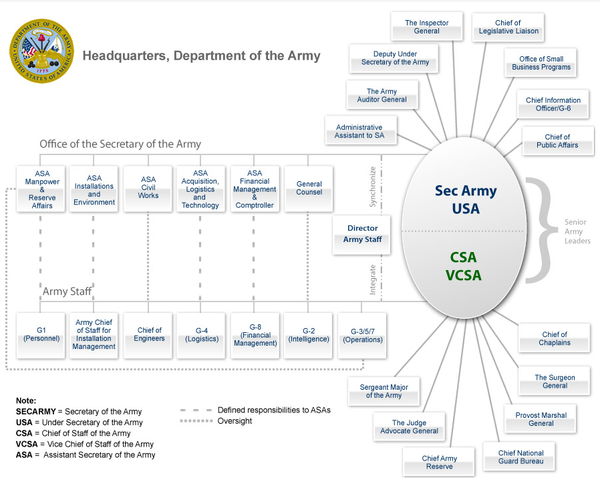m (1 revision: Import USDoD officials from Wikipedia part 2) |
m (Remove some templates. interwiki links and cleanup) |
||
| Line 1: | Line 1: | ||
| − | {{Distinguish|Chief of Staff of the United States Army}} |
||
{{Infobox political post |
{{Infobox political post |
||
|post = Secretary of the Army |
|post = Secretary of the Army |
||
Revision as of 21:17, 27 October 2013
| United States Secretary of the Army | |
|---|---|

| |
| Deputy | The Under Secretary (principal civilian deputy) The Chief of Staff (military advisor and deputy) |
| Appointed by | The President with the advice and consent of the Senate |
| Incumbent | John M. McHugh |
| Personal details | |
| Website | Official website |
The Secretary of the Army (SA or SECARMY) is a senior civilian official within the Department of Defense of the United States of America with statutory responsibility for all matters relating to the United States Army: manpower, personnel, reserve affairs, installations, environmental issues, weapons systems and equipment acquisition, communications, and financial management.
The Secretary of the Army is nominated by the President and confirmed by the U.S. Senate, the Secretary of the Army is a non-Cabinet position serving under the Secretary of Defense.[1] This position was created on September 18, 1947, replacing the Secretary of War, when the Department of War became the Department of the Army and was made a department within the new Department of Defense.[2]
The current Secretary of the Army, John M. McHugh, took office on September 21, 2009.
Responsibilities
The Senior Leadership of the Department of the Army consists of two civilians—the Secretary of the Army and the Under Secretary of the Army—and two military officers of four-star rank—the Chief of Staff of the Army and the Vice Chief of Staff of the Army.
The Secretary of the Army (10 U.S.C. § 3013) is in effect the chief executive officer of the Department of the Army, and the Chief of Staff of the Army works directly for the Secretary of the Army. The Secretary presents and justifies Army policies, plans, programs, and budgets to the Secretary of Defense, other executive branch officials, and to the Congressional Defense Committees. The Secretary also communicates Army policies, plans, programs, capabilities, and accomplishments to the public. As necessary, the Secretary convenes meetings with the senior leadership of the Army to debate issues, provide direction, and seek advice. The Secretary is a member of the Defense Acquisition Board.
The Secretary of the Army has several responsibilities under the Uniform Code of Military Justice, including the authority to convene general courts-martial.
Another responsibility of the Secretary of the Army is the management of the Civilian Aides to the Secretary of the Army Program.[3]
Office of the Secretary of the Army
The Office of the Secretary of the Army is composed of the Under Secretary of the Army, the Assistant Secretaries of the Army, the Administrative Assistant to the Secretary of the Army, the General Counsel of the Department of the Army, the Inspector General of the Army, the Chief of Legislative Liaison, and the Army Reserve Forces Policy Committee. Other offices may be established by law or by the Secretary of the Army. No more than 1,865 officers of the Army on the active-duty list may be assigned or detailed to permanent duty in the Office of the Secretary of the Army and on the Army Staff.[4]
- Under Secretary of the Army
- Assistant Secretary of the Army (Acquisition, Logistics, and Technology)
- Assistant Secretary of the Army (Civil Works)
- Assistant Secretary of the Army (Financial Management and Comptroller)
- Assistant Secretary of the Army (Installations, Energy and Environment)
- Assistant Secretary of the Army (Manpower and Reserve Affairs)
- General Counsel of the Army
- Administrative Assistant to the Secretary of the Army
- Inspector General of the Army

Chart showing the organization of the Office of the Secretary of Army and its relationship to the Army Staff.
Chronological list of Secretaries of the Army
Kenneth Claiborne Royall, the last Secretary of War, became the first Secretary of the Army when the National Defense Act of 1947 took effect and was the last Army secretary to hold the cabinet status, which was henceforth assigned to the Secretary of Defense.[2][5]
Template:Chronological list of United States Secretaries of the Army
References
- ↑ "US CODE: Title 10,3013. Secretary of the Army". http://www.law.cornell.edu/uscode/html/uscode10/usc_sec_10_00003013----000-.html. Retrieved September 22, 2007.
- ↑ 2.0 2.1 Bell, William Gardner (1992). ""Kenneth Claiborne Royall"". Secretaries of War and Secretaries of th Army: Portraits and Biographical Sketches. United States Army Center of Military History. http://www.history.army.mil/books/sw-sa/Royall.htm. Retrieved September 22, 2007.
- ↑ "Secretary of the Army". Archived from the original on September 21, 2007. http://web.archive.org/web/20070921062151/http://www.army.mil/leaders/leaders/SA/. Retrieved September 22, 2007.
- ↑ "US CODE: Title 10,3014. Office of the Secretary of the Army". http://www4.law.cornell.edu/uscode/html/uscode10/usc_sec_10_00003014----000-.html. Retrieved September 22, 2007.
- ↑ Bell, William Gardner. ""Intro - Secretaries of War & Secretaries of the Army"". Secretaries of War and Secretaries of the Army: Portraits & Biographical Sketches. http://www.history.army.mil/books/sw-sa/Intro.htm. Retrieved September 22, 2007.
External links
| |||||||||||||||
| ||||||||||||||||||||||||||||||||||||||||||||||
| |||||||||||||||||||||||||||||||||||||||||||||||||||||||||||||||||
| ||||||||||||||||||||||||||||||||||||||||||||||||||||||||||||||||||||||||||||||||||||||||||




